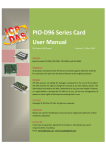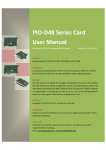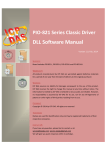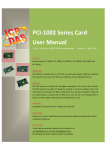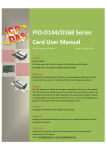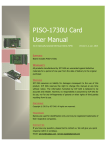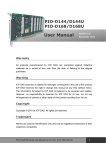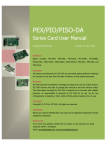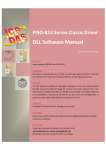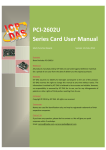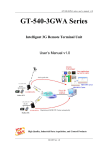Download Hardware User`s Manual
Transcript
PIO-821 Series Card User Manual 45 kS/s 12-bit, 16-ch A/D, 1-ch D/A Multi-function DAQ Board Version 2.0, Mar. 2015 SUPPORTS Board includes PIO-821L, PIO-821H, PIO-821LU and PIO-821HU. WARRANTY All products manufactured by ICP DAS are warranted against defective materials for a period of one year from the date of delivery to the original purchaser. WARNING ICP DAS assumes no liability for damages consequent to the use of this product. ICP DAS reserves the right to change this manual at any time without notice. The information furnished by ICP DAS is believed to be accurate and reliable. However, no responsibility is assumed by ICP DAS for its use, nor for any infringements of patents or other rights of third parties resulting from its use. COPYRIGHT Copyright © 2014 by ICP DAS. All rights are reserved. TRADEMARK Names are used for identification only and may be registered trademarks of their respective companies. CONTACT US If you have any question, please feel to contact us at: [email protected]; [email protected] We will give you quick response within 2 workdays. PIO-821 Series Card 45 kS/s 12-bit, 16-ch A/D, 1-ch D/A Multi-function DAQ Board TABLE OF CONTENTS 1. INTRODUCTION ................................................................................................................................................. 3 1.1 PACKING LIST........................................................................................................................................................ 4 1.2 FEATURES ............................................................................................................................................................ 4 1.3 SPECIFICATIONS .................................................................................................................................................... 5 1.3.1 Analog Input Range......................................................................................................................................... 6 1.3.2 Analog Output Range ...................................................................................................................................... 7 1.3.3 Programmable Timer/Counter ........................................................................................................................ 7 2. HARDWARE CONFIGURATION ............................................................................................................................ 8 2.1 THE BLOCK DIAGRAMS ........................................................................................................................................... 8 2.2 BOARD L AYOUT .................................................................................................................................................... 9 2.3 CARD ID SWITCH ................................................................................................................................................ 11 2.4 CONFIGURATION OF THE DA/AD OUTPUT SIGNALS ................................................................................................... 12 2.4.1 JP2: D/A Reference Voltage Selection ............................................................................................................ 12 2.4.2 JP3: D/I Port Settings (Pull-High/Low) ........................................................................................................... 12 2.4.3 JP4: A/D input type selection (S.E. /Diff.) ...................................................................................................... 13 2.4.4 A/D Input Signal Connection ......................................................................................................................... 14 2.5 CONFIGURATION OF THE 8254 CHIP ....................................................................................................................... 18 2.5.1 JP5: Chip 8254 Clock Settings (Internal/External Clock) ................................................................................ 18 2.5.2 JP6: External Gate/Internal Counter0 Settings .............................................................................................. 19 2.5.3 The 8254 Timer/Counter Connection ............................................................................................................ 20 2.6 PIN ASSIGNMENTS............................................................................................................................................... 21 3. HARDWARE INSTALLATION ...............................................................................................................................22 4. SOFTWARE INSTALLATION ................................................................................................................................26 4.1 OBTAINING/INSTALLING THE DRIVER INSTALLER PACKAGE ............................................................................................ 26 4.2 PNP DRIVER INSTALLATION ................................................................................................................................... 27 4.3 VERIFYING THE INSTALLATION ................................................................................................................................ 28 4.3.1 How do I get into Windows Device Manager? .............................................................................................. 28 4.3.2 Check that the Installation ............................................................................................................................ 30 5. TESTING PISO-821 SERIES CARD ........................................................................................................................31 5.1 SELF-TEST WIRING .............................................................................................................................................. 31 5.1.1 DIO Test Wiring ............................................................................................................................................. 31 5.1.2 Analog Input Test Wiring............................................................................................................................... 32 User Manual, Ver. 2.0, Mar. 2015, PMH-019-20, Page: 1 PIO-821 Series Card 45 kS/s 12-bit, 16-ch A/D, 1-ch D/A Multi-function DAQ Board 5.1.3 5.2 6. Analog Output Test Wiring ............................................................................................................................ 33 EXECUTE THE TEST PROGRAM ................................................................................................................................ 34 CALIBRATION ....................................................................................................................................................38 6.1 D/A CALIBRATION ............................................................................................................................................... 39 6.2 A/D CALIBRATION ............................................................................................................................................... 40 7. I/O CONTROL REGISTER ....................................................................................................................................41 7.1 HOW TO FIND THE I/O ADDRESS ............................................................................................................................ 41 7.1.1 PIO_PISO Utility............................................................................................................................................. 42 7.2 THE ASSIGNMENT OF I/O ADDRESS ........................................................................................................................ 45 7.3 THE I/O ADDRESS MAP ....................................................................................................................................... 47 7.3.1 RESET\ Control Register................................................................................................................................. 48 7.3.2 AUX Control Register ..................................................................................................................................... 48 7.3.3 AUX Data Register ......................................................................................................................................... 48 7.3.4 INT Mask Control Register ............................................................................................................................. 49 7.3.5 AUX Status Register ....................................................................................................................................... 50 7.3.6 Interrupt Polarity Control Register................................................................................................................. 50 7.3.7 8254 Counter ................................................................................................................................................. 51 7.3.8 A/D Buffer Register ........................................................................................................................................ 51 7.3.9 D/A Buffer Register ........................................................................................................................................ 52 7.3.10 D/I Input Buffer Register .............................................................................................................................. 52 7.3.11 D/O Output Buffer Register ......................................................................................................................... 53 7.3.12 A/D Gain Control and Multiplex Control Register ........................................................................................ 53 7.3.13 A/D Mode Control Register ......................................................................................................................... 54 7.3.14 A/D Software Trigger Control Register ........................................................................................................ 55 7.3.15 Card ID Register ........................................................................................................................................... 55 8. DEMO PROGRAMS............................................................................................................................................56 8.1 DEMO PROGRAM FOR WINDOWS .......................................................................................................................... 56 8.2 DEMO PROGRAM FOR DOS .................................................................................................................................. 58 APPENDIX: DAUGHTER BOARD ....................................................................................................................................59 A1. DB-37 and DN-37................................................................................................................................................. 59 A2. DB-8225............................................................................................................................................................... 59 A3. DB-16P Isolated Input Board ............................................................................................................................... 60 A4. DB-16R Relay Board ............................................................................................................................................ 61 User Manual, Ver. 2.0, Mar. 2015, PMH-019-20, Page: 2 PIO-821 Series Card 45 kS/s 12-bit, 16-ch A/D, 1-ch D/A Multi-function DAQ Board 1. Introduction The PIO-821LU/HU card is the new generation product that ICP DAS provides to meet RoHS compliance requirement. The new PIO-821LU/HU card is designed as a drop-in replacement for the PIO-821L/H, and users can replace the PIO-821L/H by the PIO-821LU/HU directly without software/driver modification. The PIO-821 series cards are a high performance multifunction board for PC/AT compatible computers. The PIO-821LU/HU universal PCI card supports 3.3 V/5 V PCI bus while the PIO-821L/H supports 5 V PCI bus. They feature a 12-bit ADC and the maximum sampling rate of the A/D converter reaches up to about 45K samples/sec., 16 single-ended or 8 differential analog input channels, 12-bit DAC voltage output and 16 TTL-compatible digital input and digital output channels. The PIO-821L/LU provides for low gain (1, 2, 4, 8); and the PIO-821H/HU supports high gain (1, 10, 100, 1000). The PIO-821LU/HU also adds a Card ID switch and pull-high/pull-low resisters for DI on board. Users can set Card ID on a board and recognize the board by the ID via software when using two or more PIO-821LU/HU cards in one computer. The pull-high/ pull-low resisters allow the DI status to be specified when the DI channels are unconnected; the DI status will remain in high or low status other than floating. These cards support various OS such as Linux, DOS, Windows 98/NT/2000 and 32/64-bit Windows 8/7/Vista/XP. DLL and Active X control together with various language sample program based on Turbo C++, Borland c++, Microsoft C++, Visual C++, Borland Delphi, Borland C++ Builder, Visual Basic, C#.NET, Visual Basic.NET and LabVIEW are provided in order to help users to quickly and easily develop their own applications. User Manual, Ver. 2.0, Mar. 2015, PMH-019-20, Page: 3 PIO-821 Series Card 45 kS/s 12-bit, 16-ch A/D, 1-ch D/A Multi-function DAQ Board 1.1 Packing List The shipping package includes the following items: One PIO-821 series card hardware One printed Quick Start Guide One software utility CD Quick Start Note: If any of these items is missing or damaged, contact the dealer from whom you purchased the product. Save the shipping materials and carton in case you want to ship or store the product in the future. 1.2 Features Support the +5V PCI bus for PIO-821L/H Support the +3.3/+5 V PCI bus for PIO-821LU/HU The maximum sampling rate of the 12-bit A/D converter is about 45 k samples/sec. 16 single-ended or 8 differential analog input channels Software selectable input ranges A/D trigger mode: software trigger, pacer trigger, external trigger Analog input range: PIO-821L/LU: ±5 V, ±2.5 V, ±1.25 V, ±0.625 V PIO-821H/HU: ±5 V, ±0.5 V, ±0.05 V, ±0.005 V Programmable high/low gain: PIO-821L/LU: 1, 2, 4, 8 PIO-821H/HU: 1, 10, 100, 1000 Supports Card ID (SMD Switch) for PIO-821LU/HU Digital input port can be set to pull-high or pull-low for PIO-821LU/HU 1-channel 12-bit D/A voltage output 16-channel 5 V/TTL digital input 16-channel 5 V/TTL digital output Interrupt handling SMD, Sort card User Manual, Ver. 2.0, Mar. 2015, PMH-019-20, Page: 4 PIO-821 Series Card 45 kS/s 12-bit, 16-ch A/D, 1-ch D/A Multi-function DAQ Board 1.3 Specifications Model Name PIO-821LU PIO-821HU PIO-821L PIO-821H Analog Input Channels 16 single-ended/ 8 differential A/D Converter 12-bit, 8 μs Conversion time Sampling Rate 45 kS/s. max. FIFO Size Over voltage Protection Input Impedance N/A Continuous +/-35 Vp-p 10 MΩ/6 pF Trigger Modes Software, Internal programmable pacer Data Transfer Polling, Interrupt Accuracy 0.01 % of FSR ±1 LSB @ 25 °C, ± 10 V Zero Drift +/- 4 ppm/°C of FSR Analog Output Channels Resolution Accuracy 1 12-bit 0.01 % of FSR ±1/2 LSB @ 25 °C, ± 10 V Output Range Unipolar:0 ~ 5 V, 0 ~ 10 V, 0 ~ Ext Ref Output Driving +/- 5 mA Slew Rate 0.3 V/μs Output Impedance Operating Mode 0.1 Ω max. Software Digital Input Channels 16 Compatibility 5 V/TTL Input Voltage Logic 0: 0.8 V max.; Logic 1: 2.0 V min. Response Speed 1.2 MHz (Typical) Digital Output Channels Compatibility Output Voltage 16 5 V/TTL Logic 0: 0.4 V max.; Logic 1: 2.4 V min. Output Capability Sink: 2.4 mA @ 0.8 V; Source: 0.8 mA @ 2.0 V Response Speed 1.2 MHz (Typical) User Manual, Ver. 2.0, Mar. 2015, PMH-019-20, Page: 5 PIO-821 Series Card 45 kS/s 12-bit, 16-ch A/D, 1-ch D/A Multi-function DAQ Board Model Name PIO-821LU PIO-821HU PIO-821L PIO-821H Timer/Counter Channels 3(Internal pacer x 1/Independent x 2) Resolution 16-bit Compatibility 5 V/TTL Input Frequency 10 MHz max. Reference Clock Internal: 2 MHz General Bus Type 3.3 V/5 V Universal PCI, 32-bit, 33 MHz Data Bus 8-bit Card ID Yes(4-bit) No Female DB37 x 1 I/O Connector Dimensions (L x W x D) 5 V PCI, 32-bit, 33 MHz 20-pin box header x 2 159 mm x 97 mm x 22mm Power Consumption 183 mm x 105 mm x 22 mm 960 mA @ +5 V Operating Temperature 0 ~ 60 °C Storage Temperature -20 ~ 70 °C Humidity 5 ~ 85% RH, non-condensing 1.3.1 Analog Input Range Model Gain Bipolar PIO-821L/LU (Low-Gain) 1 2 4 8 ±5 V ±2.5 V ±1.25 V ±0.625 V Sampling Rate Max. 45 kS/s. Model Gain Bipolar Sampling Rate Max. PIO-821H/HU (High-Gain) 1 10 100 1000 ±5 V ±0.5 V ±0.05 V ±0.005 V 10 kS/s. 1 kS/s. 45 kS/s. User Manual, Ver. 2.0, Mar. 2015, PMH-019-20, Page: 6 PIO-821 Series Card 45 kS/s 12-bit, 16-ch A/D, 1-ch D/A Multi-function DAQ Board 1.3.2 Analog Output Range Data Input Analog Output 1111 1111 1111 -Vref (4095/4096) 0000 0000 0000 -Vref (1/4096) 0000 0000 0000 0 Volts 1.3.3 Programmable Timer/Counter Type: 82C54 programmable timer/counter. Timers: three 16-bit independent timers. Timer 2 is used as the internal A/D pacer trigger timer. Timer 0 and Timer 1 are used as the machine independent timer. Timer 0 could use external clock by setting JP5. User Manual, Ver. 2.0, Mar. 2015, PMH-019-20, Page: 7 PIO-821 Series Card 45 kS/s 12-bit, 16-ch A/D, 1-ch D/A Multi-function DAQ Board 2. Hardware Configuration 2.1 The Block Diagrams The block diagram of the PIO-821 series is illustrated below in order to assist users in understanding the data flow within the hardware and software system structure. Figure 2-1 User Manual, Ver. 2.0, Mar. 2015, PMH-019-20, Page: 8 PIO-821 Series Card 45 kS/s 12-bit, 16-ch A/D, 1-ch D/A Multi-function DAQ Board 2.2 Board Layout Figure 2.2 and Figure 2.3 shows the layout of the PIO-821L/H and PIO-821LU/HU boards and the locations of the configuration jumper and connector for signal wiring. Board Layout of the PIO-821L/H. 10V 5V PIO-821L/H JP1 JP4 PCI controller CON1 CON3 CON2 JP2 JP5 JP6 PCI BUS Figure 2-2 CON1 The terminal for digital input CON2 The terminal for digital output CON3 The terminal for the A/D and D/A converters for voltage input/output JP1 JP2 JP4 JP5 JP6 No use D/A reference voltage selection A/D input type selection (Single-End or Differential) External Clock/Internal Clock (2MHz) External Gate/Counter0 (COUT0) Refer to Sec.2.6 for more detailed about pin assignments information. Refer to Sec.2.4.1 Refer to Sec.2.4.3 Refer to Sec.2.5.1 Refer to Sec.2.5.2 User Manual, Ver. 2.0, Mar. 2015, PMH-019-20, Page: 9 PIO-821 Series Card 45 kS/s 12-bit, 16-ch A/D, 1-ch D/A Multi-function DAQ Board Board Layout of the PIO-821LU/HU. JP2 PIO-821L/H 10V 5V JP6 CON2 JP4 SW1 PCI controller CON1 CON3 JP5 JP1 JP3 Universal PCI BUS Figure 2-3 CON1 The terminal for digital input Refer to Sec.2.6 for more detailed about pin assignments information. CON2 The terminal for digital output CON3 The terminal for the A/D and D/A converters for voltage input/output JP1 JP2 No use D/A reference voltage selection Refer to Sec.2.4.1 JP3 JP4 JP5 JP6 SW1 Pull-high or pull-low for DI A/D input type selection (Single-End or Differential) External Clock/Internal Clock (2MHz) External Gate/Counter0 (COUT0) Card ID function Refer to Sec.2.4.2 Refer to Sec.2.4.4 Refer to Sec.2.5.1 Refer to Sec.2.5.2 Refer to Sec.2.3 User Manual, Ver. 2.0, Mar. 2015, PMH-019-20, Page: 10 PIO-821 Series Card 45 kS/s 12-bit, 16-ch A/D, 1-ch D/A Multi-function DAQ Board 2.3 Card ID Switch The PIO-821LU/HU has a Card ID switch (SW1) with which users can recognize the board by the ID via software when using two or more PIO-821LU/HU cards in one computer. The default Card ID is 0x0. For detail SW1 Card ID settings, please refer to Table 2-1. Note that the Card ID function is only supported by the PIO-821LU/HU. NO ID 2 ID 3 ID 1 ID 0 SW1 1 2 3 4 (Default Settings) (*) Default Settings; OFF 1; ON 0 1 2 Card ID (Hex) ID0 ID1 Table 2-1 3 ID2 4 ID3 (*) 0x0 ON ON ON ON 0x1 OFF ON ON ON 0x2 ON OFF ON ON 0x3 OFF OFF ON ON 0x4 ON ON OFF ON 0x5 OFF ON OFF ON 0x6 ON OFF OFF ON 0x7 OFF OFF OFF ON 0x8 ON ON ON OFF 0x9 OFF ON ON OFF 0xA ON OFF ON OFF 0xB OFF OFF ON OFF 0xC ON ON OFF OFF 0xD OFF ON OFF OFF 0xE ON OFF OFF OFF 0xF OFF OFF OFF OFF User Manual, Ver. 2.0, Mar. 2015, PMH-019-20, Page: 11 PIO-821 Series Card 45 kS/s 12-bit, 16-ch A/D, 1-ch D/A Multi-function DAQ Board 2.4 Configuration of the DA/AD Output Signals 2.4.1 JP2: D/A Reference Voltage Selection JP2 is used to configure the internal reference voltage for analog output. There are two types of internal reference voltages, which are 5 V or 10 V. The reference voltage settings are presented in Figure 2-4. The 5 V reference voltages provide a 0 to 5 V range of analog voltage output for the A/D converter. In the same way, the 10 V reference voltages support a functional range between 0 to 10 V of analog voltage output. Figure 2-4 10V 10V JP2 JP2 5V 5V Reference Voltage = 5 V (Default Settings) Reference Voltage = 10 V 2.4.2 JP3: D/I Port Settings (Pull-High/Low) This DI ports can be pull-high or pull-low that is selected by JP3. The pull-high/low jumpers of the card allow user to predefine the DI status instead of floating when the DI channels are unconnected or broken. The configuration is illustrated in the figure below. Note: This function only supports PIO-821LU/HU. Vcc GND Pull-High Figure 2-5 JP3 JP3 Vcc GND Pull-Low (Default) User Manual, Ver. 2.0, Mar. 2015, PMH-019-20, Page: 12 PIO-821 Series Card 45 kS/s 12-bit, 16-ch A/D, 1-ch D/A Multi-function DAQ Board 2.4.3 JP4: A/D input type selection (S.E. /Diff.) JP4 is used to select the type of analog input between single-ended and differential inputs. As shown in Figure 2-6 (a), the user needs to connect pin 1, 3 and pin 2, 4 to obtain the single-ended measurement for the analog input signal, which is the default setting. However, for the differential signal measurement, the pin 3, 5 and pin 4, 6 for the JP4 jumper should be connected as shown Figure 2-6 (b). Furthermore, based on the type of analog input configuration, the PIO-821 series cards can offer 16 single-ended or 8 differential analog input measurement channels. Notice that all the measurements of analog input channels are configured at the same time according to the chosen setting of single-ended or differential methods. Figure 2-6 JP4 JP4 1 2 1 2 5 6 5 6 (a) Single-Ended Inputs (Default) (b) Differential User Manual, Ver. 2.0, Mar. 2015, PMH-019-20, Page: 13 PIO-821 Series Card 45 kS/s 12-bit, 16-ch A/D, 1-ch D/A Multi-function DAQ Board 2.4.4 A/D Input Signal Connection The PIO-821 series card can measure either single-ended or differential-type analog input signals. The user must decide which mode is most suitable for measurement purposes. Please refer to the section 2.4.3 to see how to configure the JP4 jumper based on your analog input type. In general, there are four different analog signal connection methods, as shown in Figure 2-7 to Figure 2-10. The connection shown in Figure 2-7 is suitable for grounded analog input signals. The connection shown in Figure 2-8 is used to measure more channels than that shown in Figure 2-7, but is only suitable for large analog input signals. The connection shown in Figure 2-9 is suitable for thermocouple connections and the connection shown in Figure 2-10 is suitable for floating analog input signals. Note: In Figure 2-9, the maximum common mode voltage between the analog input source and the AGND is 70 Vp-p, so the user must ensure that the input signals is within this specification. If the common mode voltage is above 70 Vp-p, the input multiplexer will be permanently damaged! The simplest way to select your input signal connection configuration is listed below. 1. Grounding source input signal 2. Thermocouple input signal 3. Floating source input signal 4. If Vin > 0.1 V, gain<=10 and more channels are needed 5. Current source input signal see Figure 2-7 see Figure 2-9 see Figure 2-10 see Figure 2-8 see Figure 2-11 If you are unsure of the characteristics of your input signal, follow these test steps: Step1: Step2: Step3: Step4: Try and record the measurement results when using Figure 2-7. Try and record the measurement results when using Figure 2-10. Try and record the measurement results when using Figure 2-8. Compare the three results and select the best one. User Manual, Ver. 2.0, Mar. 2015, PMH-019-20, Page: 14 PIO-821 Series Card 45 kS/s 12-bit, 16-ch A/D, 1-ch D/A Multi-function DAQ Board Figure 2-7: Differential input with grounded source (Right way) Figure 2-7 A/D CH0 HI Es 1 S Es n S A/D CH 0 LO A.GND 1 A/D CH n HI A/D CHn LO A.GND n Figure 2-8: Single-ended input with floating signal source Figure 2-8 A/D CH0 A/D CH1 A/D CH n Es AGND User Manual, Ver. 2.0, Mar. 2015, PMH-019-20, Page: 15 PIO-821 Series Card 45 kS/s 12-bit, 16-ch A/D, 1-ch D/A Multi-function DAQ Board Figure 2-9: Differential input with floating thermocouple signal Figure 2-9 A/D CH 0 HI Note: If the input signal is not thermocouple, the user should use an oscilloscope to measure common mode voltage of Vin before connecting to PIO-821 series card. Don’t use a voltage meter or multi-meter. A/D CH 0 LO A/D CH n HI A/D CH n LO A. GND Do not join LO to A.GND at the computer CAUTION: In Figure 2-9, the maximum common mode voltage between the analog input source and the AGND is 70 Vp-p. Make sure that the input signal is under specification first! If the common mode voltage is over 70 Vp-p, the input multiplexer will be permanently damaged. Figure 2-10: Differential input with floating signal source Figure 2-10 A/D CH 0 HI Es 1 A/D CH 0 LO A.GND A/D CH n HI Es n A/D CH n LO A.GND User Manual, Ver. 2.0, Mar. 2015, PMH-019-20, Page: 16 PIO-821 Series Card 45 kS/s 12-bit, 16-ch A/D, 1-ch D/A Multi-function DAQ Board Figure 2-11: Connecting to a 4 ~ 20 mA Source AI CHn + R (Shunt Resistor) AGND - Example: A 20 mA source current through a 125 Ω resistor (e.g. 125 Ω, 0.1% DIP Resistors) between + and – terminals and the board will read a 2.5 VDC voltage. You can use the I = V/R (Ohm’s law) to calculate what value the source current should have. Current (I) = Voltage (V) / Resistance (R) = 2.5 V / 125 Ω = 0.02 A = 20 m Figure 2-12: Signal Shielding Signal shielding connections in Figure 2-7 to Figure 2-11 are all the same, as show in the below figure. Use a single-point connection to frame ground (not A.GND or D.GND) Figure 2-11 PIO-821 Series Card A.GND D.GND Vin Frame Ground User Manual, Ver. 2.0, Mar. 2015, PMH-019-20, Page: 17 PIO-821 Series Card 45 kS/s 12-bit, 16-ch A/D, 1-ch D/A Multi-function DAQ Board 2.5 Configuration of the 8254 Chip 2.5.1 JP5: Chip 8254 Clock Settings (Internal/External Clock) The function of the 8254 chip is used to provide the hardware sampling mechanism and counter operation. There is two ways to provide the clock source, which are (1) On board oscillator 2 MHz called as Internal clock; (2) External clock source that comes in from the connector pin and can be provided by user. In below the detail clock source setting will be brought up. The PIO-821 series card can be selected to use either the external or internal clock as a signal source of the timer 0 of IC 82c54. This selection is made by the JP5 jumper, as shown in Figure 2-12. The left hand side diagram shows the setting for the internal clock at 2 MHz. On the other hand, the right hand side diagram shows the setting for external clock. The clock signal source is controlled by the external source. However, the maximum frequency of the clock source is limited by 10 MHz. Figure 2-12 PIO-821 L/H PIO-821 LU/HU EXT_CLK Internal Clock 2 MHz (Default) JP5 JP5 2 MHz EXT_CLK 2 MHz EXT_CLK 2 MHz EXT_CLK External Clock JP5 JP5 2 MHz User Manual, Ver. 2.0, Mar. 2015, PMH-019-20, Page: 18 PIO-821 Series Card 45 kS/s 12-bit, 16-ch A/D, 1-ch D/A Multi-function DAQ Board 2.5.2 JP6: External Gate/Internal Counter0 Settings The PIO-821 series card can also be set to use the external gate or internal Cout0 (Counter0) signal to control the 82c54’s counter2 through the use of the JP6 jumper, as shown in Figure 2-13. The left hand diagram of Figure 2-13 is the default setting for the external gate signal control and the right hand diagram shows the internal Cout0 signal control. Figure 2-13 PIO-821 L/H PIO-821 LU/HU COUT0 EXT_GATE (Default) JP6 JP6 EXT_GATE COUT0 EXT_GATE COUT0 COUT0 JP6 JP6 EXT_GATE COUT0 EXT_GATE User Manual, Ver. 2.0, Mar. 2015, PMH-019-20, Page: 19 PIO-821 Series Card 45 kS/s 12-bit, 16-ch A/D, 1-ch D/A Multi-function DAQ Board 2.5.3 The 8254 Timer/Counter Connection The 8254 Programmable timer/counter has 4 registers from wBase+0xC0 through wBase+0xCC. For detailed programming information about 8254, please refer to Intel‘s “Microsystem Components Handbook”. The block diagram is as below. 10 k Figure 2-14 EXT_GATE0 VCC Gate0 COUT0 Cin0 JP5 EXT_CLK INT_CLK 2 MHz 10 k VCC 1 2 3 Gate1 2 MHz COUT1 COUT2 JP6 1 EXT_GATE2 2 3 Cin2 10 k VCC COUT1 Cout1 Cin1 COUT0 COUT0 Cout0 Gate2 Pacer Cout2 8254 Timer/Counter Note: Cin: Clock Input Cout: Clock Output INT_CLK: Internal Clock EXT_CLK: External Clock EXT_GATE: External GATE The counter0, counter1 and counter2 are all 16-bit counter. The counter0 and counter2 can be cascaded as a 32-bit timer. The counter2 is used in pacer trigger, PIO821_SetChannelConfig() and PIO821_Delay() functions, so they cannot be used in the same time. User Manual, Ver. 2.0, Mar. 2015, PMH-019-20, Page: 20 PIO-821 Series Card 45 kS/s 12-bit, 16-ch A/D, 1-ch D/A Multi-function DAQ Board 2.6 Pin Assignments The Pin assignments of CON1, CON2 and CON3 on the PIO-821 series cards are represented in the figure below. CON1/CON2: 20-pin flat-cable headers for digital input/output. CON1/2 are TTL compatible High (1) 2.0 ~ 5.0 V(Voltage over 5.0V will damage the device) None Define 2.0 V ~ 0.8 V Low (0) Under 0.8 V CON3: 37-pin D-type female connector for analog input/output and Timer/Counter. User Manual, Ver. 2.0, Mar. 2015, PMH-019-20, Page: 21 PIO-821 Series Card 45 kS/s 12-bit, 16-ch A/D, 1-ch D/A Multi-function DAQ Board 3. Hardware Installation Note: It’s recommended to install driver first, since some operating system (such as Windows 2000) may ask you to restart the computer again after driver installation. This reduces the times to restart the computer. To install the PIO-821 series card, follow the procedure described below: Step 1: Installing PIO-821 series card driver on your computer first. For detailed information about the driver installation, please refer to Chapter 4 Software Installation. Step 2: Configuring Card ID by the SW1 DIP-Switch for PIO-821LU/HU only. For detailed information about the card ID (SW1), please refer to Sec. 2.3 Car ID Switch . User Manual, Ver. 2.0, Mar. 2015, PMH-019-20, Page: 22 PIO-821 Series Card 45 kS/s 12-bit, 16-ch A/D, 1-ch D/A Multi-function DAQ Board Step 3: Shut down and power off your computer. Step 4: Remove all covers from the computer. Step 5: Select an empty PCI slot. User Manual, Ver. 2.0, Mar. 2015, PMH-019-20, Page: 23 PIO-821 Series Card 45 kS/s 12-bit, 16-ch A/D, 1-ch D/A Multi-function DAQ Board Step 6: Remove the PCI slot cover form the PC. Step 7: Remove the connector cover form the PIO-821 series card. Step 8: Carefully insert your PIO-821 series card into the PCI slot. User Manual, Ver. 2.0, Mar. 2015, PMH-019-20, Page: 24 PIO-821 Series Card 45 kS/s 12-bit, 16-ch A/D, 1-ch D/A Multi-function DAQ Board Step 9: Tighten the screw. Confirm the PIO-821 series card is mounted on the motherboard. Step 10: Replace the computer cover. Step 11: Power on the computer. Follow the prompt message to finish the Plug&Play steps, please refer to Chapter 4 Software Installation. User Manual, Ver. 2.0, Mar. 2015, PMH-019-20, Page: 25 PIO-821 Series Card 45 kS/s 12-bit, 16-ch A/D, 1-ch D/A Multi-function DAQ Board 4. Software Installation This chapter provides a detailed description of the process for installing the PIO-821 series driver and how to verify whether the PIO-821 was properly installed. PIO-821 series card can be used on DOS, Linux and Windows 98/ME/2000 and 32-/64-bit XP/2003/Vista/7/8 based systems, and the drivers are fully Plug and Play (PnP) compliant for easy installation. 4.1 Obtaining/Installing the Driver Installer Package The driver installer package for the PIO-821 series card can be found on the supplied CD-ROM, or can be obtained from the ICP DAS FTP web site. Install the appropriate driver for your operating system. The location and addresses are indicated in the Table4-1 and Table 4-2 below. Table 4-1: UniDAQ Driver/SDK OS Windows 2000、32/64-bit Windows XP、32/64-bit Windows 2003、 32/64-bit Windows Vista、32/64-bit Windows 7、32/64-bit Windows 2008、 32/64-bit Windows 8 Driver Name UniDAQ Driver/SDK (unidaq_win_setup_xxxx.exe) CD-ROM CD:\\ NAPDOS\PCI\UniDAQ\DLL\Driver\ Web Site http://ftp.icpdas.com/pub/cd/iocard/pci/napdos/pci/unidaq/dll/driver/ Installing Procedure For detailed information about the UniDAQ driver installation, please refer to UniDAQ DLL Software Manual. The user manual is contained in: CD:\NAPDOS\PCI\UniDAQ\Manual\ http://ftp.icpdas.com/pub/cd/iocard/pci/napdos/pci/unidaq/manual/ User Manual, Ver. 2.0, Mar. 2015, PMH-019-20, Page: 26 PIO-821 Series Card 45 kS/s 12-bit, 16-ch A/D, 1-ch D/A Multi-function DAQ Board Table 4-2: PIO-821 Series Classic Driver OS Windows 95/98/ME、Windows NT、Windows 2000、32-bit Windows XP、 32-bit Windows 2003、32-bit Windows Vista、32-bit Windows 7 Driver Name PIO-821 Series Classic (PIO-821_Win_Setup_xxx_x86.exe) CD-ROM CD:\\ NAPDOS\PCI\PIO-821\DLL\Driver\ Web Site http://ftp.icpdas.com/pub/cd/iocard/pci/napdos/pci/pio-821/dll/driver/ Installing For detailed information about the PIO-821 series classic driver installation, please refer to PIO-821 series classic driver DLL Software Manual. The user manual is contained in: CD:\NAPDOS\PCI\PIO-821 \Manual\ Procedure http://ftp.icpdas.com/pub/cd/iocard/pci/napdos/pci/pio-821/manual/ 4.2 PnP Driver Installation Power off the computer and install the PIO-821 series cards. Turn on the computer and Windows 95/98/ME/NT/2000 and 32-/64-bit Windows XP/2003/Vista/7/8 should automatically defect the new PCI device(s) and then ask for the location of the driver files for the hardware. If a problem is encountered during installation, refer to the PnPinstall.pdf file for more information. User Manual, Ver. 2.0, Mar. 2015, PMH-019-20, Page: 27 PIO-821 Series Card 45 kS/s 12-bit, 16-ch A/D, 1-ch D/A Multi-function DAQ Board 4.3 Verifying the Installation Please open the Device Manager to verify the installation. Below are the steps for entering the Device Manager in each of the major versions of windows. Refer to appropriate for your OS, continue to complete the following steps: 4.3.1 How do I get into Windows Device Manager? Microsoft Windows 95/98/ME users Step 1: On the desktop right-click on “My Computer” and click “Properties” or open the “Control Panel” and double-click the “System” icon. Step 2: Click the “Device Manager” tab. Microsoft Windows 2000/XP users Step 1: Select “Start Settings Control Panel” and double-click the “System” icon. Step 2: Click the “Hardware” tab and then click the “Device Manager” button. Microsoft Windows 2003 users Step 1: Open the “Administrative Tools” in Control Panel. Step 2: Within the Administrative Tools click “Computer Management”. User Manual, Ver. 2.0, Mar. 2015, PMH-019-20, Page: 28 PIO-821 Series Card 45 kS/s 12-bit, 16-ch A/D, 1-ch D/A Multi-function DAQ Board Microsoft Windows Vista/7 users Step 1: Click on the “Start” button. Step 2: In the Start Search box type device manager and then press enters. Microsoft Windows 8 users Step 1: To show the Start screen icon from the desktop view, simply hover your cursor over the bottom-left corner of your screen. (Or using keyboard shortcuts, click [Windows Key] +[ X] to open the Start Menu.) Step 2: Right-click on the Start screen icon then click on “Device Manager”. Right-click User Manual, Ver. 2.0, Mar. 2015, PMH-019-20, Page: 29 PIO-821 Series Card 45 kS/s 12-bit, 16-ch A/D, 1-ch D/A Multi-function DAQ Board 4.3.2 Check that the Installation Check the PIO-821 series card which listed correctly or not, as illustrated below. Installation successful User Manual, Ver. 2.0, Mar. 2015, PMH-019-20, Page: 30 PIO-821 Series Card 45 kS/s 12-bit, 16-ch A/D, 1-ch D/A Multi-function DAQ Board 5. Testing PISO-821 Series Card This chapter can give you the detail steps about self-test. In this way, user can confirm that PIO-821 series card well or not. Before the self-test, you must complete the hardware and driver installation. For detailed information about the hardware and driver installation, please refer to Chapter 3 Hardware Installation and Chapter 4 Software Installation. 5.1 Self-Test Wiring 5.1.1 DIO Test Wiring Use the CA-2002 cable (optional) to connect the CON1 with CON2 on the PIO-821 series card. User Manual, Ver. 2.0, Mar. 2015, PMH-019-20, Page: 31 PIO-821 Series Card 45 kS/s 12-bit, 16-ch A/D, 1-ch D/A Multi-function DAQ Board 5.1.2 Analog Input Test Wiring Prepare for device: DN-37 (optional) wiring terminal board. Provide a stable signal source. (For example, dry battery) Step 1: Use the DN-37 to connect the CON3 on the PIO-821 series card. Step 2: Wire the signal source to A/D channel0, and then keep set the JP4 jumper to Single-Ended (default settings, refer to Sec. 2.4.3 for more detailed), and wire the signals as follows: Connect the AI 0 (Pin01) to signal positive (+) and then A.GND (Pin09) to signal negative (-). User Manual, Ver. 2.0, Mar. 2015, PMH-019-20, Page: 32 PIO-821 Series Card 45 kS/s 12-bit, 16-ch A/D, 1-ch D/A Multi-function DAQ Board 5.1.3 Analog Output Test Wiring Prepare for device: DN-37 (optional) wiring terminal board. Digital Multi-Meter. Step 1: Use the DN-37 to connect the CON3 on the PIO-821 series card. Step 2: Wire the signal source to D/A channel, and then keep set the JP2 jumper to 5 V (default settings, refer to Sec. 2.4.1 for more detailed), and wire the signals as follows: Connect the positive probe (+) of Multi-meter to DAOUT (Pin 30), and then the negative probe (-) of Multi-meter to A.GND (Pin 29). User Manual, Ver. 2.0, Mar. 2015, PMH-019-20, Page: 33 PIO-821 Series Card 45 kS/s 12-bit, 16-ch A/D, 1-ch D/A Multi-function DAQ Board 5.2 Execute the Test Program The following example use UniDAQ driver to perform self-test. If you install the PIO-821 series classic driver, please refer to Quick Start Guide of the PIO-821 (http://ftp.icpdas.com/pub/cd/iocard/pci/napdos/pci/pio-821/manual/quickstart/classic/pio-821_q uickstart_eng_v11.pdf) to execute the self-test. Step 1: Execute the UniDAQ Utility Program. The UniDAQ Utility.exe will be placed in the default path (C:\ICPDAS\UniDAQ\Driver\) after completing installation. 1. Double click the “UniDAQUtility.exe” 2. Confirm the PIO-821 series card had successfully installed to PC. It starts form 0. 3. Click the “TEST” button to start test. 1 2 3 User Manual, Ver. 2.0, Mar. 2015, PMH-019-20, Page: 34 PIO-821 Series Card 45 kS/s 12-bit, 16-ch A/D, 1-ch D/A Multi-function DAQ Board Step 2: Get DIO function test result. Click “Digital Output” item. 4 6 Check channel 0, 2, 4, 6 Select the “Port 0” 5 Click “Digital Input” item. 7 9 The corresponding D/I becomes red for channel 0, 2, 4, 6 of D/O is ON. Select the “Port 0” 8 User Manual, Ver. 2.0, Mar. 2015, PMH-019-20, Page: 35 10 PIO-821 Series Card 45 kS/s 12-bit, 16-ch A/D, 1-ch D/A Multi-function DAQ Board Step 3: Get Analog Input function test result. 10 Click “Analog Input” item. Confirm the configuration setting. Click this button to start test. 11 12 13 Check analog input on Channel 0 textbox. The other channels value for floating number. User Manual, Ver. 2.0, Mar. 2015, PMH-019-20, Page: 36 PIO-821 Series Card 45 kS/s 12-bit, 16-ch A/D, 1-ch D/A Multi-function DAQ Board Step 4: Get Analog Output function test result. Click “Analog Output” item. 14 Click this button. 18 15 Select the “Channel 0” 17 16 Select the “0 ~ 5V” Type the voltage value The value read on meter may be a little difference from the DA value because of the resolution limit of meter or the measurement error. 2.499 19 Check the value on multi-meter, they should be identical to the values set in program. User Manual, Ver. 2.0, Mar. 2015, PMH-019-20, Page: 37 PIO-821 Series Card 45 kS/s 12-bit, 16-ch A/D, 1-ch D/A Multi-function DAQ Board 6. Calibration The PIO-821 is already fully calibrated when shipped from the factory including the calibration coefficients which are stored in the EEPROM on board. For more precise application of voltages at the “system end”, the following procedure provides a method that allows you to calibrate the board within your system, so that you can achieve the correct voltages at your field connection. This calibration allows the user to remove the effects of voltage drops caused by IR loss in the cable and/or connector. At first the user has to prepare the equipment for calibration: the precise multi-meter. Note that the calibrated values for analog output and analog input channels are stored within 3 words in the address of the EEPROM, as show in Table6-1. The calibration procedure will be demonstrated below: Table 6-1: Calibration values stored in the EEPROM address The address of the EEPROM for Analog output 5V 0 10 V 1 0V The address of the EEPROM for Analog input 2 The calibration.exe program for the ICP DAS PIO-821 series can be found on the supplied CD-ROM, or can be obtained from the ICP DAS FTP web site. The location and addresses are indicated in the table 6-2 below: (Note: Before beginning the “A/D and D/A Calibration” process, the PIO-821 series classic driver installation must be completed. For detailed information regarding PIO-821 series classic driver installation, refer to section 4.1.2.) Table 6.2 CD:\\ NAPDOS\PCI\PIO-821\DLL\Calibrate\ http://ftp.icpdas.com/pub/cd/iocard/pci/napdos/pci/pio-821/dll/calibrate/ User Manual, Ver. 2.0, Mar. 2015, PMH-019-20, Page: 38 PIO-821 Series Card 45 kS/s 12-bit, 16-ch A/D, 1-ch D/A Multi-function DAQ Board 6.1 D/A Calibration Figure 6-1 Calibration for 5 V mode Step 1: Set the JP2 jumper on PIO-821 to the 5V position (refer to Sec. 2.4.1). 1 Step 2: Run the calibration tool, which is located in “/program files/ DAQpro/PIO-821/calibation.exe” in order to open the configuration 2 interface, as shown in Figure 6-1. Step 3: If you want to calibrate the DA, for example, then let the “DA value” be set at 4095, as shown in 3 Figure 6-1 (1). 4 Step 4: Click the “DA Output” button and then use particular multi-meter to measure the analog output, as shown in Figure 6-1 (2). Step 5: If the analog output is smaller or bigger than the allowed maximum (5.00 V) value of analog output, then go to step 3 to step 4 to change the output value (for example: 4093, 4092,…) and change the output voltage until its value is equal to the allowed maximum voltage output value, as shown in Figure 6-1 (3). Step 6: If the analog output is equal to the maximum allowed analog output level, please key in the calibration value to “5 V calibration value” in the textbox and Click the “Write EEP” button. The DA calibration process is finished for the setting range of analog output. It is shown in Figure 6-1 (4). Calibration for 10 V mode Please refer to the Calibration for 5 V mode, but the JP2 jumper has to be configured at the 10 V output range and the allowance set to the maximum value at 10.00 V. User Manual, Ver. 2.0, Mar. 2015, PMH-019-20, Page: 39 PIO-821 Series Card 45 kS/s 12-bit, 16-ch A/D, 1-ch D/A Multi-function DAQ Board 6.2 A/D Calibration Step 1: Set the JP4 jumper on PIO-821 to the differential input position (refer to Sec. 2.4.3) and connect the AI0+ (CON3, pin1) and AI0- (CON3, pin20) of analog input channel 0 together, as shown in the following Figure6-2. CON3 Cable: CA-3710 DN-37 I/O Wiring 20 21 22 23 24 25 26 27 28 29 30 31 32 33 34 35 36 37 1 2 3 4 5 6 7 8 9 10 11 12 13 14 15 16 17 18 19 Figure 6-2 Step 2: Click the "AD calibration" button to write the value of the analog input channel 0 into the text field of the “AD calibration value” , as shown in Figure 6-3 (1). Step 3: Click the “Write EEP” button to save the calibration data into the EEPROM to finish the calibration process, as shown in Figure 6-3 (2). 1 2 Figure 6-3 User Manual, Ver. 2.0, Mar. 2015, PMH-019-20, Page: 40 PIO-821 Series Card 45 kS/s 12-bit, 16-ch A/D, 1-ch D/A Multi-function DAQ Board 7. I/O Control Register 7.1 How to Find the I/O Address The plug&play BIOS will assign a proper I/O address to every PIO/PISO series card in the power-on stage. The fixed IDs for the PIO-821 series cards are given as follows: Table 7-1: PIO-821L/H (Rev 2.0 or above) PIO-821LU/HU PIO-821L/H (Rev 1.0) Vendor ID 0xE159 Vendor ID 0xE159 Device ID 0x02 Device ID 0x01 Sub-Vendor ID 0x80 Sub-Vendor ID Sub-Device ID 0x03 Sub-Device ID 0x03 Sub-Aux ID 0x00 Sub-Aux ID 0x00 0x00FF 0x40FF We provide all necessary functions as follows: 1. PIO_DriverInit(&wBoard, wSubVendor, wSubDevice, wSubAux) 2. PIO_GetConfigAddressSpace(wBoardNo,*wBase,*wIrq, *wSubVendor, *wSubDevice, *wSubAux, *wSlotBus, *wSlotDevice) 3. Show_PIO_PISO(wSubVendor, wSubDevice, wSubAux) All functions are defined in PIO.H. Refer to PIO-821 DLL software manual for more information. The important driver information is given as follows: 1. Resource-allocated information: wBase: BASE address mapping in this PC wIrq: IRQ channel number allocated in this PC User Manual, Ver. 2.0, Mar. 2015, PMH-019-20, Page: 41 PIO-821 Series Card 45 kS/s 12-bit, 16-ch A/D, 1-ch D/A Multi-function DAQ Board 2. PIO/PISO identification information: wSubVendor: subVendor ID of this board wSubDevice: subDevice ID of this board wSubAux: subAux ID of this board 3. PC’s physical slot information: wSlotBus: hardware slot ID1 in this PC’s slot position wSlotDevice: hardware slot ID2 in this PC’s slot position The PIO_PISO.EXE utility will detect and show all PIO/PISO cards installed in this PC. Refer to Sec. 7.1.1 for more information. 7.1.1 PIO_PISO Utility The PIO_PISO.EXE is valid for all PIO/PISO cards. This program shows all PCI hardware ID regarding the PIO and PISO series DAQ cards. It is useful to test if the card Plug & Play successfully when the computer bootup. If the PIO or PISO series card does not shown in the screen correctly, please try to use another PCI slot and try again. The user can execute the PIO_PISO.EXE to get the following information: List all PIO/PISO cards installed in this PC List all resources allocated to every PIO/PISO cards List the wSlotBus and wSlotDevice for specified PIO/PISO card identification. (refer to Sec. 7.2 for more information about the assignment of I/O Address) User Manual, Ver. 2.0, Mar. 2015, PMH-019-20, Page: 42 PIO-821 Series Card 45 kS/s 12-bit, 16-ch A/D, 1-ch D/A Multi-function DAQ Board For Windows OS The PIO_PISO.EXE for Windows is contained in: CD:\NAPDOS\PCI\Utility\Win32\PIO_PISO http://ftp.icpdas.com/pub/cd/iocard/pci/napdos/pci/utility/win32/pio_piso/ After executing the utility, the detail information for all PIO/PISO cards that installed in the PC will be shown as follows: User Manual, Ver. 2.0, Mar. 2015, PMH-019-20, Page: 43 PIO-821 Series Card 45 kS/s 12-bit, 16-ch A/D, 1-ch D/A Multi-function DAQ Board For DOS The PIO_PISO.EXE for DOS is contained in: CD:\NAPDOS\PCI\Utility\DOS\ http://ftp.icpdas.com/pub/cd/iocard/pci/napdos/pci/utility/dos/ The PIO_PISO program source is given as follows: /* -------------------------------------------------------------- */ /* Find all PIO_PISO series cards in this PC system */ /* step 1 : plug all PIO_PISO cards into PC */ /* step 2 : run PIO_PISO.EXE */ /* ------------------------------------------------------------- */ #include "PIO.H" WORD wBase,wIrq; WORD wBase2,wIrq2; int main() { int i,j,j1,j2,j3,j4,k,jj,dd,j11,j22,j33,j44; WORD wBoards,wRetVal; WORD wSubVendor,wSubDevice,wSubAux,wSlotBus,wSlotDevice; char c; float ok,err; clrscr(); wRetVal=PIO_DriverInit(&wBoards,0xff,0xff,0xff); /*for PIO-PISO */ printf("\nThrer are %d PIO_PISO Cards in this PC",wBoards); if (wBoards==0 ) exit(0); printf("\n-----------------------------------------------------"); for(i=0; i<wBoards; i++) { PIO_GetConfigAddressSpace(i,&wBase,&wIrq,&wSubVendor, &wSubDevice,&wSubAux,&wSlotBus,&wSlotDevice); printf("\nCard_%d:wBase=%x,wIrq=%x,subID=[%x,%x,%x], SlotID=[%x,%x]",i,wBase,wIrq,wSubVendor,wSubDevice, wSubAux,wSlotBus,wSlotDevice); printf(" --> "); ShowPioPiso(wSubVendor,wSubDevice,wSubAux); } PIO_DriverClose(); } User Manual, Ver. 2.0, Mar. 2015, PMH-019-20, Page: 44 PIO-821 Series Card 45 kS/s 12-bit, 16-ch A/D, 1-ch D/A Multi-function DAQ Board 7.2 The Assignment of I/O Address The Plug&Play BIOS will assign the proper I/O address to a PIO/PISO series card. If there is only one PIO/PISO board, the user can identify the board as card_0. If there are two PIO/PISO boards in the system, it is very difficult to identify which board is card_0. The software driver can support a maximum of 16 boards. Therefore, the user can install 16 PIO/PSIO series cards onto one PC system. The methods used to find and identify card_0 and card_1 is demonstrated below. The simplest way to identify which card is card_0 is to use wSlotBus and wSlotDevice in the following manner: Step 1: Remove all PIO-821 series boards from the PC. Step 2: Install one PIO-821 series into the PC’s PCI_slot1, run PIO_PISO.EXE. Then record the wSlotBus1 and wSlotDevice1 information. Step 3: Remove all PIO-821 series boards from the PC. Step 4: Install one PIO-821 series into the PC’s PCI_slot2 and run PIO_PISO.EXE. Then record the wSlotBus2 and wSlotDevice2 information. Step 5: Repeat Steps(3) and (4) for every PCI_slot and record all information from wSlotBus and wSlotDevice. The records may look similar to the table follows: Table 7-2: PC’s PCI Slot WslotBus WslotDevice Slot_1 0 0x07 Slot_2 0 0x08 Slot_3 0 0x09 Slot_4 0 0x0A Slot_5 1 0x0A Slot_6 1 0x08 Slot_7 1 0x09 Slot_8 1 0x07 PCI-BRIDGE User Manual, Ver. 2.0, Mar. 2015, PMH-019-20, Page: 45 PIO-821 Series Card 45 kS/s 12-bit, 16-ch A/D, 1-ch D/A Multi-function DAQ Board The above procedure will record all the wSlotBus and wSlotDevice information on a PC. These values will be mapped to this PC’s physical slot and this mapping will not be changed for any PIO/PISO cards. Therefore, this information can be used to identify the specified PIO/PISO card by following steps: Step1: Using the wSlotBus and wSlotDevice information from Table 7-2. Step2: Enter the board number into PIO_GetConfigAddressSpace(…) function to get the information for a specific card, especially the wSlotBus and wSlotDevice details. Step3: Identify the specific PIO/PISO card by comparing the data of the wSlotBus and wSlotDevice from Step1 and Step2. Note: that normally the card installed in slot 0 is card0 and the card installed in slot1 is card1 for PIO/PISO series cards. User Manual, Ver. 2.0, Mar. 2015, PMH-019-20, Page: 46 PIO-821 Series Card 45 kS/s 12-bit, 16-ch A/D, 1-ch D/A Multi-function DAQ Board 7.3 The I/O Address Map The I/O address for PIO-821 series cards are automatically assigned by the main board ROM BIOS. The I/O address can also be re-assigned by the user. It is strongly recommended that users do not change the I/O address. The Plug&Play BIOS will effectively perform the assignment of proper I/O addresses to each PIO-821 series card. The I/O address for the PIO-821 series card are given in the table below, all of which are based on the base address of each card. Table 6-3: Refer to Sec. 7.1 for more information about wBase. Address Read Write wBase+0x0 RESET\ Control Register RESET\ Control Register wBase+0x2 AUX Control Register AUX Control Register wBase+0x3 AUX Data Register AUX Data Register wBase+0x5 INT Mask Control Register INT Mask Control Register wBase+0x7 AUX Pin Status Register AUX Pin Status Register wBase+0x2a INT Polarity Control Register INT Polarity Control Register wBase+0xc0 8254-Counter0 8254-Counter0 wBase+0xc4 8254-Counter1 8254-Counter1 wBase+0xc8 8254-Counter2 8254-Counter2 wBase+0xcc - 8254 Control Word wBase+0xd0 A/D Low Byte D/A Low Byte wBase+0xd4 A/D High Byte D/A High Byte wBase+0xd8 DI Low Byte DO Low Byte wBase+0xdc DI High Byte DO High Byte wBase+0xe0 - A/D Gain Control and Multiplexer Control wBase+0xe4 - A/D Mode Control wBase+0xe8 - A/D Software Trigger Control wBase+0xec A/D Status - wBase+0xf0 Read Card ID - User Manual, Ver. 2.0, Mar. 2015, PMH-019-20, Page: 47 PIO-821 Series Card 45 kS/s 12-bit, 16-ch A/D, 1-ch D/A Multi-function DAQ Board 7.3.1 RESET\ Control Register (Read/Write): wBase+0x0 Bit 7 Bit 6 Bit 5 Bit 4 Bit 3 Bit 2 Bit 1 Bit 0 Reserved Reserved Reserved Reserved Reserved Reserved Reserved RESET\ When the PC’s power is first turned on, RESET\ signal is in a Low-state. This will disable all D/I/O operations. The user has to set the RESET\ signal to a High-state before any D/A command applications are initiated. 7.3.2 AUX Control Register (Read/Write): wBase+0x2 Bit 7 Bit 6 Bit 5 Bit 4 Bit 3 Bit 2 Bit 1 Bit 0 Aux7 Aux6 Aux5 Aux4 Aux3 Aux2 Aux1 Aux0 This register is designed for feature extension and for enable or disable of the reading/writing data from or to the EEPROM. And it is reversed for internal utilization and do not apply this control register under any consideration. 7.3.3 AUX Data Register (Read/Write): wBase+0x3 Bit 7 Bit 6 Bit 5 Bit 4 Bit 3 Bit 2 Bit 1 Bit 0 Aux7 Aux6 Aux5 Aux4 Aux3 Aux2 Aux1 Aux0 This register controls the read/write function of the EEPROM on board. There are all reversed by ICPDAS internal use. If the user wants to access this EEPROM, please refer to the function read/write of the EEPROM provided by the driver toolkit. User Manual, Ver. 2.0, Mar. 2015, PMH-019-20, Page: 48 PIO-821 Series Card 45 kS/s 12-bit, 16-ch A/D, 1-ch D/A Multi-function DAQ Board 7.3.4 INT Mask Control Register (Read/Write): wBase+0x5 Bit 7 Bit 6 Bit 5 Bit 4 Bit 3 Bit 2 Bit 1 Bit 0 0 0 0 0 0 0 EN1 EN2 The INT mask control register is presented as following table. The detail function for these control register is described as below. INT0 : ADC ready INT1 : Timer 0 EN0=0 EN0=1 EN1=0 EN1=1 disable INT0 to be an interrupt signal (default) enable INT0 to be an interrupt signal disable INT1 to be an interrupt signal (default) enable INT1 to be an interrupt signal The following is the partial programs for DOS C development environment enable or disable interrupt function. For more information, please refer to the DOS demo program demo1.c. For example: outportb(wBase+5,0); outportb(wBase+5,1); outportb(wBase+5,2); outportb(wBase+5,3); // disable all interrupts // enable interrupt of INT0 // enable interrupt of INT1 // enable all two channels of interrupt User Manual, Ver. 2.0, Mar. 2015, PMH-019-20, Page: 49 PIO-821 Series Card 45 kS/s 12-bit, 16-ch A/D, 1-ch D/A Multi-function DAQ Board 7.3.5 AUX Status Register (Read/Write): wBase+0x7 Bit 7 Bit 6 Bit 5 Bit 4 Bit 3 Bit 2 Bit 1 Bit 0 Aux7 Aux6 Aux5 Aux4 Aux3 Aux2 Aux1 Aux0 Based on the auxiliary status register, Aux0 (bit 0) and Aux 1(bit 1) stand as INT0 and INT1 signal respectively. Aux2 to Aux3 (bit2 to 3) represents the control register of the EEPROM and Aux4 to Aux7 (bit4 to 7) depicts the Aux-ID. Generally, the Aux 0 to 1 are used as interrupt sources. Interrupt service has to check this register to start service routing. 7.3.6 Interrupt Polarity Control Register (Read/Write): wBase+0x2a Bit 7 Bit 6 Bit 5 Bit 4 Bit 3 Bit 2 Bit 1 Bit 0 0 0 0 0 - - INV1 INV0 The interrupt polarity control register is presented as following table. It is used to invert the interrupt signal or not. The detail function for these control register is described as below. INT0 : ADC ready INT1 : Timer 0 INV0=0 invert signal from INT0; INV0=1 INV1=0 INV1=1 do not invert signal from INT0; invert signal from INT1; do not invert signal from INT0; The following is the partial programs for DOS C development environment enable or disable inverting function for interrupt signal. For example: outportb(wBase+0x2a,0); /* select the inverted input from all 2 channels */ outportb(wBase+0x2a,3); /* select the non-inverted input from all 2 channels */ outportb(wBase+0x2a,2); /* select the inverted input of INT0 */ /* select the non-inverted input from the others */ User Manual, Ver. 2.0, Mar. 2015, PMH-019-20, Page: 50 PIO-821 Series Card 45 kS/s 12-bit, 16-ch A/D, 1-ch D/A Multi-function DAQ Board 7.3.7 8254 Counter Address Read Write wBase+0xc0 8254-Counter0 8254-Counter0 wBase+0xc4 8254-Counter1 8254-Counter1 wBase+0xc8 8254-Counter2 8254-Counter2 wBase+0xcc - 8254 Control Word The 8254 Programmable timer/counter has 4 registers from wBase+0xc0 through wBase+0xcc. For detailed programming information about 8254, please refer to Intel‘s “Microsystem Components Handbook”. 7.3.8 A/D Buffer Register (Read): wBase+0xd0 A/D Low Byte Data Format Bit 7 Bit 6 Bit 5 Bit 4 Bit 3 Bit 2 Bit 1 Bit 0 D7 D6 D5 D4 D3 D2 D1 D0 (Read): wBase+0xd4 A/D High Byte Data Format Bit 7 Bit 6 Bit 5 Bit 4 Bit 3 Bit 2 Bit 1 Bit 0 0 0 0 0 D11 D10 D9 D8 (Read): wBase+0xec Read A/D Status Bit 7 Bit 6 Bit 5 Bit 4 Bit 3 Bit 2 Bit 1 Bit 0 - - - - - - - READY A/D 12 bits data: D11 to D0, D11=MSB, D0=LSB READY = 0: A/D 12 bits data not ready = 1: A/D 12 bits data is ready The low 8 bits A/D data are stored in address wBase+0xd0 and the high 4 bits data are stored in address wBase+0xd4. The READY bit is used as an indicator for A/D conversion. When an A/D conversion is completed, the READY bit will be set to 1. User Manual, Ver. 2.0, Mar. 2015, PMH-019-20, Page: 51 PIO-821 Series Card 45 kS/s 12-bit, 16-ch A/D, 1-ch D/A Multi-function DAQ Board 7.3.9 D/A Buffer Register (Write): wBase+0xd0 D/A Low Byte Data Format Bit 7 Bit 6 Bit 5 Bit 4 Bit 3 Bit 2 Bit 1 Bit 0 D7 D6 D5 D4 D3 D2 D1 D0 (Write): wBase+0xd4 D/A High Byte Data Format Bit 7 Bit 6 Bit 5 Bit 4 Bit 3 Bit 2 Bit 1 Bit 0 0 0 0 0 D11 D10 D9 D8 The D/A converter will convert the 12 bits digital data to analog output. The low 8 bits of D/A channel are stored in address wBase +4 and high 4 bits are stored in address wBase +5. The D/A output latch registers are designed as a “double buffered” structure, so the analog output latch registers will be updated until the high 4 bits digital data are written. The user must send low 8 bits first and then send high 4 bits to update the 12 bits AD output latch register. 7.3.10 D/I Input Buffer Register Read): wBase+0xd8 D/I Low Byte Data Format Bit 7 Bit 6 Bit 5 Bit 4 Bit 3 Bit 2 Bit 1 Bit 0 D7 D6 D5 D4 D3 D2 D1 D0 (Read): wBase+0xdc D/I High Byte Data Format Bit 7 Bit 6 Bit 5 Bit 4 Bit 3 Bit 2 Bit 1 Bit 0 D15 D14 D13 D12 D11 D10 D9 D8 DI 16 bits input data: D15 to D0, D15=MSB, D0=LSB The PIO-821 series card provides 16 TTL compatible digital inputs. The low 8 bits are stored in address wBase +0xd8. The high 8 bits are stored in address wBase +0xdc. User Manual, Ver. 2.0, Mar. 2015, PMH-019-20, Page: 52 PIO-821 Series Card 45 kS/s 12-bit, 16-ch A/D, 1-ch D/A Multi-function DAQ Board 7.3.11 D/O Output Buffer Register (Write): wBase+0xd8 D/O Low Byte Data Format Bit 7 Bit 6 Bit 5 Bit 4 Bit 3 Bit 2 Bit 1 Bit 0 D7 D6 D5 D4 D3 D2 D1 D0 (Write): wBase+0xdc D/O High Byte Data Format Bit 7 Bit 6 Bit 5 Bit 4 Bit 3 Bit 2 Bit 1 Bit 0 D15 D14 D13 D12 D11 D10 D9 D8 The PIO-821L/H provides 16 TTL compatible digital outputs. The low 8 bits are stored in address wBase+0xd8. The high 8 bits are stored in address wBase+0xdc. 7.3.12 A/D Gain Control and Multiplex Control Register (Write): wBase+0xe0 D/O Low Byte Data Format Bit 7 Bit 6 Bit 5 Bit 4 Bit 3 Bit 2 Bit 1 Bit 0 - - MUX3 MUX2 MUX1 MUX0 GAIN1 GAIN0 PIO-821L/LU GAINS Control Code Table: GAIN Input Range GAIN1 GAIN0 Setting Time 1 ±5 V 0 0 23 μs 2 ±2.5 V 0 1 23 μs 4 ±1.25 V 1 0 25 μs 8 ±0.6255 V 1 1 28 μs PIO-821H/HU GAINS Control Code Table: GAIN Input Range GAIN1 GAIN0 Setting Time 1 ±5 V 0 0 23 μs 10 ±2.5 V 0 1 28 μs 100 ±1.25 V 1 0 140 μs 1000 ±0.6255 V 1 1 1300 μs User Manual, Ver. 2.0, Mar. 2015, PMH-019-20, Page: 53 PIO-821 Series Card 45 kS/s 12-bit, 16-ch A/D, 1-ch D/A Multi-function DAQ Board The only difference between PIO-821L/LU and PIO-821H/HU is the GAIN control function. The PIO-821L/LU provides gain factor of 1, 2, 4, 8 and PIO-821H/HU provides 1, 10, 100, 1000. The gain control registers control the gain of A/D input signal. Note: If gain control code changed, the hardware needs to delay extra gain settling time. The gain settling time is different for different gain control code. The software driver does not take care of the gain settling time, so the user needs to delay the gain settling time if gain changed. A/D input channel selection data = 4 bits: MUX3 to MUX0, MUX3=MSB, D0= MUX0, “ - “=don‘t care Single-ended mode: MUX3... MUX0 Differential mode: MUX2... MUX0, MUX3 =don’t care 7.3.13 A/D Mode Control Register (Write): wBase+0xe4 Bit 7 Bit 6 Bit 5 Bit 4 Bit 3 Bit 2 Bit 1 Bit 0 1 1 1 1 0 ExtTrig PacerTrig SoftTrig The PIO-821 series card provides software trigger, pacer trigger and external trigger modes to get A/D input signal. Bit 2 to Bit 0 =0 SoftTrig = 1 : reset the AD trigger mode : Enable Software Trigger Mode PacerTrig = 1 ExtTrig = 1 : Enable Pacer Trigger Mode : Enable External Trigger Mode The following is the partial programs for DOS C development environment to set A/D mode: For example: outportb(wBase+0xe4, 0xF1); // enable software trigger mode outportb(wBase+0xe4, 0xF2); // enable pacer trigger mode outportb(wBase+0xe4, 0xF4); // enable external trigger mode outportb(wBase+0xe4, 0xF0); // reset the AD trigger mode User Manual, Ver. 2.0, Mar. 2015, PMH-019-20, Page: 54 PIO-821 Series Card 45 kS/s 12-bit, 16-ch A/D, 1-ch D/A Multi-function DAQ Board 7.3.14 A/D Software Trigger Control Register (Write): wBase+0xe8 Bit 7 Bit 6 Bit 5 Bit 4 Bit 3 Bit 2 Bit 1 Bit 0 0 0 0 0 0 0 0 A/D The A/D converter will convert the analog input data by software control. After setting section 7.3.13 A/D Mode Control Register to software trigger mode, writing 1 to A/D software trigger control register will trigger A/D converter to complete an A/D conversion. For example: outportb(wBase+0xe8, 0x01); 7.3.15 // convert A/D data once Card ID Register (Read): wBase+0xf0 Bit 7 Bit 6 Bit 5 Bit 4 Bit 3 Bit 2 Bit 1 Bit 0 0 0 0 0 ID3 ID2 ID1 ID0 For example: wCardID = inportb(wBase+0xf0); /* read Card ID */ Note: The Card ID function is only supported by the PIO-821LU/HU (Ver. 1.0 or above) User Manual, Ver. 2.0, Mar. 2015, PMH-019-20, Page: 55 PIO-821 Series Card 45 kS/s 12-bit, 16-ch A/D, 1-ch D/A Multi-function DAQ Board 8. Demo Programs 8.1 Demo Program for Windows All demo programs will not work properly if the DLL driver has not been installed correctly. During the DLL driver installation process , the install-shields will register the correct kernel driver to the operation system and copy the DLL driver and demo programs to the correct position based on the driver software package you have selected (Win98/Me/NT/2K and 32-/64-bit winXP/2003/Vista/7/8). Once driver installation is complete, the related demo programs and development library and declaration header files for different development environments will be presented as follows. Demo Program for PIO-821 Series Classic Driver The demo program is contained in: CD:\NAPDOS\PCI\PIO-821\DLL\Demo\ http://ftp.icpdas.com/pub/cd/iocard/pci/napdos/pci/pio-821/dll/demo/ BCB4 for Borland C++ Builder 4 PIO821.H Header files PIO821.LIB Linkage library for BCB only Delphi4 for Delphi 4 PIO821.PAS Declaration files VC6 for Visual C++ 6 PIO821.H Header files PIO821.LIB Linkage library for VC only VB6 for Visual Basic 6 PIO821.BAS Declaration files VB.NET2005 for VB.NET2005 PIO821.vb Visual Basic Source files CSharp2005 for C#.NET2005 PIO821.cs Visual C# Source files For detailed information about the DLL function of the PIO-821 series card, please refer to PIO-821 DLL Software Manual (CD:\NAPDOS\PCI\PISO-821\Manual\) User Manual, Ver. 2.0, Mar. 2015, PMH-019-20, Page: 56 PIO-821 Series Card 45 kS/s 12-bit, 16-ch A/D, 1-ch D/A Multi-function DAQ Board Demo Program for UniDAQ SDK Driver The demo program is contained in: CD:\NAPDOS\PCI\UniDAQ\DLL\Demo\ http://ftp.icpdas.com/pub/cd/iocard/pci/napdos/pci/unidaq/dll/demo/ BCB6 for Borland C++ Builder 6 UniDAQ.H Header files UniDAQ.LIB Linkage library for BCB only Delphi6 for Delphi 6 UniDAQ.PAS Declaration files VB6 for Visual Basic 6 UniDAQ.BAS Declaration files CSharp2005 for C#.NET2005 UniDAQ.cs Visual C# Source files VC6 for Visual C++ 6 UniDAQ.H Header files UniDAQ.LIB Linkage library for VC only VB.NET2005 for VB.NET2005 UniDAQ.vb Visual Basic Source files VC.NET2005 for VC.NET2005 (32-bit) UniDAQ.H Header files UniDAQ.LIB Linkage library for VC only VC.NET2005 for VC.NET2005 (64-bit) UniDAQ.H Header files UniDAQ.LIB Linkage library for VC only For detailed information about the DLL function and demo program of the UniDAQ, please refer to UniDAQ DLL Software Manual (CD:\NAPDOS\PCI\UniDAQ\Manual\) User Manual, Ver. 2.0, Mar. 2015, PMH-019-20, Page: 57 PIO-821 Series Card 45 kS/s 12-bit, 16-ch A/D, 1-ch D/A Multi-function DAQ Board 8.2 Demo Program for DOS The demo program is contained in: CD:\NAPDOS\PCI\PIO-821\DOS\ http://ftp.icpdas.com/pub/cd/iocard/pci/napdos/pci/pio-821/dos/ \TC\*.* for Turbo C 2.xx or above \TC\LIB\*.* for TC Library \TC\DEMO\*.* for TC demo program \TC\DIAG\*.* for TC diagnostic program \TC\LIB\PIO.H \TC\LIB\TCPIO_L.LIB \TC\LIB\TCPIO_H.LIB TC Declaration File TC Large Model Library File TC Huge Model Library File For detailed information about the DLL function of the DOS, please refer to PIO-821 DLL Software Manual (CD:\NAPDOS\PCI\PIO-821\Manual\) User Manual, Ver. 2.0, Mar. 2015, PMH-019-20, Page: 58 PIO-821 Series Card 45 kS/s 12-bit, 16-ch A/D, 1-ch D/A Multi-function DAQ Board Appendix: Daughter Board A1. DB-37 and DN-37 DB-37: The DB-37 is a general purpose daughter board for D-sub 37 pins. It is designed for easy wire connection via pin-to-pin. Use a 37-pin cable (e.g. CA-3710, etc.) to connect DB-37 to CON1 of the PIO-821 series card. DB-37 DN-37: The DN-37 is a general purpose daughter board for DB-37 pins with DIN-Rail Mountings. They are also designed for easy wire connection via pin-to-pin. Use a 37-pin cable (e.g. CA-3710, etc.) to connect to CON1 of the PISO-813 series card by DN-37. DN-37 A2. DB-8225 The DB-8225 provides an onboard CJC (Cold Junction Compensation) circuit for thermocouple measurement, and terminal block for easy signal connection and measurement. The CJC is connected to A/D channel_0 and CON3 on the PIO-821 can be directly connected to the DB-8225 via a 37-pin D-Sub connector. Refer to the “DB-8225 User Manual” for details. DB-8225 User Manual, Ver. 2.0, Mar. 2015, PMH-019-20, Page: 59 PIO-821 Series Card 45 kS/s 12-bit, 16-ch A/D, 1-ch D/A Multi-function DAQ Board A3. DB-16P Isolated Input Board The DB-16P is a 16-channel isolated digital input daughter board. The optically isolated inputs of the DB-16P are consisted of are bi-directional optocoupler with resistor for current sensing. You can use the DB-16P to sense DC signal from TTL levels up to 24 V or use the DB-16P to sense a wide range of AC signals. You can use this board to isolate the computer from large common-mode voltage, ground loops and transient voltage spike that often occur in industrial environments. DB-16P Opto-Isolated R V+ PIO-821 series card D/I D/I V- 20-Pin cable PIO-821 series card DB-16P AC or DC Signal 0 V~24 V User Manual, Ver. 2.0, Mar. 2015, PMH-019-20, Page: 60 PIO-821 Series Card 45 kS/s 12-bit, 16-ch A/D, 1-ch D/A Multi-function DAQ Board A4. DB-16R Relay Board The DB-16R is a 16-channel relay output board consisting of 16 Form C relays that enable efficient switching of a load using programmable control. It is both a connector and functionally is compatible with 785 series boards, but with an industrial type terminal block. The relay is powered by applying a 5 V signal to the appropriate relay channel on the 20-pin flat connector. There are 16 LEDs for each relay, which illuminated when their associated relay is activated. This board includes a screw terminal that can be used to connect an external DB-16R power supply in order to prevent overloading your PC’s power supply. The application example for the DB-16R in the PIO-821 is illustrated in below figure. Form C Relay Normally Open Normally Closed Com D/O 20-Pin cable PIO-821 series card DB-16R Note: Channel: 16 Form C Relay Relay: Switching up to 0.5 A at 110 VAC/ 1 A at 24 VDC User Manual, Ver. 2.0, Mar. 2015, PMH-019-20, Page: 61































































